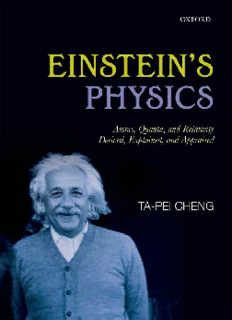
Einstein's Physics: Atoms, Quanta, and Relativity - Derived, Explained, and Appraised PDF
Preview Einstein's Physics: Atoms, Quanta, and Relativity - Derived, Explained, and Appraised
Einstein’s Physics AlbertEinsteinatBarnesFoundationinMerionPA,c.1947. PhotographybyLauraDelanoCondax;gifttotheauthorfromVannaCondax. Einstein’s Physics Atoms, Quanta, and Relativity Derived, Explained, and Appraised TA-PEI CHENG UniversityofMissouri–St.Louis PortlandStateUniversity 3 3 GreatClarendonStreet,Oxford,OX26DP, UnitedKingdom OxfordUniversityPressisadepartmentoftheUniversityofOxford. ItfurtherstheUniversity’sobjectiveofexcellenceinresearch,scholarship, andeducationbypublishingworldwide.Oxfordisaregisteredtrademarkof OxfordUniversityPressintheUKandincertainothercountries ©Ta-PeiCheng2013 Themoralrightsoftheauthorhavebeenasserted Impression:1 Allrightsreserved.Nopartofthispublicationmaybereproduced,storedin aretrievalsystem,ortransmitted,inanyformorbyanymeans,withoutthe priorpermissioninwritingofOxfordUniversityPress,orasexpresslypermitted bylaw,bylicenceorundertermsagreedwiththeappropriatereprographics rightsorganization.Enquiriesconcerningreproductionoutsidethescopeofthe aboveshouldbesenttotheRightsDepartment,OxfordUniversityPress,atthe addressabove Youmustnotcirculatethisworkinanyotherform andyoumustimposethissameconditiononanyacquirer BritishLibraryCataloguinginPublicationData Dataavailable ISBN978–0–19–966991–2 Printedandboundby CPIGroup(UK)Ltd,Croydon,CR04YY LinkstothirdpartywebsitesareprovidedbyOxfordingoodfaithand forinformationonly.Oxforddisclaimsanyresponsibilityforthematerials containedinanythirdpartywebsitereferencedinthiswork. To Leslie This page intentionally left blank Preface Einsteinexplainedinequations AlbertEinstein’sachievementinphysicsisproverbial.Manyregardhimasthe greatest physicist since Newton. What did he do in physics that’s so import- ant?WhiletherehavebeenmanybooksaboutEinstein,mostoftheseexplain his achievement only in qualitative terms. This is rather unsatisfactory as the language of physics is mathematics. One needs to know the equations in order to understand Einstein’s physics: the precise nature of his contribu- tion, its context, and its influence. The most important scientific biography of Einstein has been the one by Abraham Pais: Subtle is the Lord... The Science and the Life of Albert Einstein: The physics is discussed in depth; however, it is still a narrative account and the equations are not worked out in detail. Thus this biography assumes in effect a high level of physics back- ground that is perhaps beyond what many readers, even working physicists, possess. Our purpose is to provide an introduction to Einstein’s physics at a level accessible to an undergraduate physics student. All physics equa- tions are worked out from the beginning. Although the book is written with primarily a physics readership in mind, enough pedagogical support material is provided that anyone with a solid background in an introductory physics course(say,anengineer)can,withsomeeffort,understandagoodpartofthis presentation. In historical context This is a physics book with material presented in the historical context. Although it is not a scholarly history and there is hardly anyoriginalworkintheEinsteinbiography,historicalmaterialfromsecondary sourcesisusedtomakethephysicsmaterialmorecomprehensibleandinterest- ing.Forexample,amorecarefuldiscussionoftheresultsobtainedbyHendrik LorentzwillprecedeEinstein’sspecialrelativity.Planck’sandEinstein’swork onblackbodyradiationarepresentedonlyafterreviewingfirstthethermody- namics and scaling results of Wilhelm Wien. Our opinion is that the history conveyed through standard physics textbooks sometimes misses the proper contextofthediscovery.TheoriginalEinsteinstoryisactuallymoreinteresting andilluminating. Post-Einstein development Also, we do not stop at Einstein’s discovery, but carry the discussion onto some of the advances in physics that had been madebecauseofEinstein’scontribution.Wediscussgaugesymmetryleading totheStandardModelofparticlephysicsasalegacyofEinstein’sinvariance- principleapproach.AsanexampleofEinstein’sunifiedfieldtheorywepresent the Kaluza–Klein unification of electromagnetism and gravitation in a space viii Preface with an extra dimension. Such knowledge is needed to fully appreciate the profoundinfluencethatEinstein’sphysicshadonsubsequentdevelopment. Canyouanswerthese“Einsteinquestions”? PhysicsstudentshavealreadylearntaspectsofEinstein’sphysics—fromseg- ments in their course work or from popular accounts. Here is a list of 21 1Brief answers are given in Appendix C, Einsteinquestions.Canyouanswerthem?1 wherethereadercanalsofindthechapterand sectionnumberswherethediscussionof,and 1. Einstein’s research played a significant part in people’s acceptance of answerto,suchEinsteinquestionsarecarried therealityofthemolecularconstituentsofmatter.Inoneyear,1905,he outinthetext. showedthreeseparatewaystodeduceAvogadro’snumberfrommacro- scopicmeasurements.Whatwerethethreeareasinphysicswherethese deductions were made? Surprisingly, one of these was the blackbody radiation. 2. Einstein’s celebrated Brownian motion paper did not have the words “Brownianmotion”initstitle.Howcome? 3. Einstein’s 1905 photoelectric paper, where the idea of light quanta was firstproposed, andwhichwastheworkcitedwhenhewasawarded the Nobel Prize, was concerned mostly with a statistical study of black- body radiation. If the papers on quantum theory by Planck and by Einstein were both concerned with blackbody radiation, what was their keydifference? 4. Intheclassicaltheorywehavean“ultravioletcatastrophe”fortheblack- bodyradiation.Howdoesthepostulateofenergyquantizationcurethis problem? 5. Einstein’s quantum theory of specific heat is historically important because it is the first instance when the quantum idea was shown to be relevanttophysicalsystemswellbeyondtheesotericcaseofblackbody radiation.Histheoryalsoclarifiedthequestionsaboutmatter’smolecular composition.Howisthatso? 6. The statement of wave–particle duality was made first by Einstein in his 1909 study of fluctuations of radiation energy. Einstein and Bohr had influenced each other’s work, especially with respect to the idea of quantumtransitions(thequantumjumps).Howdidquantummechanics andquantumfieldtheoryaccommodate,inoneelegantframework,sim- ultaneouslywaves,particles,andquantumjumps?Famously,thisisnot theresolutionthatEinsteinwasabletoaccept. 7. Einsteinneveracceptedtheorthodoxinterpretationofquantummechan- ics. Was he just too set in his ways to appreciate the new advances in physics? How had Einstein’s criticism influenced subsequent investiga- tiononthemeaningofquantummechanics? 8. BythetimeEinsteinproposedhisspecialtheoryofrelativity,theLorentz transformationhadalreadybeenwrittendown.Einsteinwasunawareof this latest development, as he was working (in the Swiss Patent Office) outsideanacademicenvironment.Einstein’sderivationofthistransform- ationruledifferedfundamentallyfromthewayitwasgottenbyLorentz andothers.How? 9. While the Michelson–Morley measurement did not play a direct role in Einstein’s motivation for special relativity, there were other results Preface ix (stellar aberration, Fizeau’s experiment, and Fresnel’s formula) that Einstein had acknowledged as having had an influence. In what ways weretheyrelevanttoEinstein’smotivation?Howweretheyexplainedin thefinalrelativitytheory? 10. The key element of special relativity is the new conception of time. Just about all the counter-intuitive relativistic effects spring from the relativity of simultaneity. What about the well-known result of “length contraction”?Doesithavethisconnectionwithtimealso?Ifso,how? 11. Whatisthedifferencebetweenthespecialandgeneraltheoriesofrelativ- ity? Special relativity is applicable to electromagnetism, mechanics, thermodynamics, etc. but not to gravity (why not?); on the other hand, general relativity is the field theory of gravitation. Why then is special relativityspecialandgeneralrelativitygeneral?Whydoestheprinciple ofgeneralrelativityautomaticallybringgravityintotheconsideration? 12. Einstein originally dismissed Minkowski’s geometrical formulation of hisrelativitytheoryas“superfluouslearnedness”.WhatcausedEinstein tochange thisappraisal later on? Withrespect totheroleof mathemat- ics in the discovery of physics theory, how did Einstein’s view evolve? Was Einstein a great mathematician as well as a great physicist? What differencewoulditmake? 13. What was the idea that Einstein called “my happiest thought”? Which moment of elation was characterized by his biographer Pais as “by far the strongest emotional experience in Einstein’s scientific life, perhaps, inallhislife”? 14. Einstein’s general relativity is said to be a geometric theory of gravity. Whatdoesonemeanbya“geometrytheory”?HowdidEinsteingetthe idea that “a gravitational field is simply spacetime with curvature”? To what physical realm exactly does Einstein’s theory extend Newtonian gravity? 15. Onewaytostatetheequivalenceofinertiaandgravitationistosaythat gravitycanalwaysbetransformedawaylocally(bygoingtoareference frameinfreefall).Thustheessenceofgravityisrepresentedbyitsdiffer- entials (tidal forces). How does this feature appear in the field equation ofgeneralrelativity(theEinsteinequation)? 16. AccordingtoEinstein’sgravitytheory,shakingamassgivesrisetograv- itational waves. Because gravity is such a weak force, it is extremely difficult to detect the resultant waves. At this moment there is no con- firmedevidencefortheirdirectdetection.Nevertheless,consequencesof gravitationalwaveemissionhavebeenmeasuredandfoundinagreement withEinstein’sprediction.Whataretheseindirecteffects? 17. It is well known that black holes are regions where gravity is so strong even light cannot escape. Black holes demonstrate the full power and gloryofgeneralrelativityalsobecause,insideblackholes,“therolesof spaceandtimeareinterchanged”!Whatdoesthismean?Howdoesthis comeabout? 18. Planck’s discovery of Planck’s constant allowed him to construct, from h, c, and G , a natural unit system of mass-length-time. Through the N essential contribution by Einstein, we now understand each of these
Description: